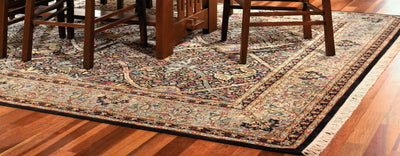
Harvey Ellis: A lasting impression
Share
 Print
Print
[originally posted February 2021]
“Altogether, he is to be regretted as one who possessed the sacred fire of genius.” This often-quoted tribute to Harvey Ellis, written by Gustav Stickley, appeared in The Craftsman magazine in February 1904, weeks after the death of the man who was all too briefly Stickley’s employee and collaborator.

For reasons we may never fully know, Ellis was a unique talent whose impact on American design is not widely recognized. But in the few months he spent in the Craftsman Workshops at the end of his life, he made his mark on Stickley and the American Arts and Crafts movement.
Architect and draftsman
Born in 1852 in Rochester, New York, Harvey Ellis was an artist practically from the cradle, drawing imaginative characters and scenes from a young age. He discovered a knack for architectural drafting as he reached adulthood and formed a business with his brother Charles, building houses and public buildings in and around Rochester. Starting in the late 1880s, Ellis spent several years working for architectural firms in various midwestern cities, including Minneapolis, St. Louis, and St. Joseph, Missouri.

Many of the designs attributed to him are in the castle-like Romanesque Revival style, with arches and turrets that seem to fit with his fanciful childhood imagination. But though some of his designs were built, it was as a brilliant draftsman and perspective renderer that Harvey Ellis really made his reputation, more widely acclaimed for his drawings than for his buildings.
A fateful meeting
Ellis returned to Rochester in 1893 and spent years immersed in painting, illustration, and the English Arts and Crafts movement, teaching art and eventually co-founding the Rochester Arts and Crafts Society. It was likely here, organizing a Stickley exhibition in Rochester in 1903, that Ellis met Gustav Stickley, and the course of his life shifted one last time. Gus brought him to his Craftsman Workshops in Syracuse in May of 1903 to design homes for The Craftsman magazine.

Before long Ellis had helped revamp the magazine’s look and contributed several exhaustive articles and illustrations of his exterior and interior home designs.
Style shift
And his presence in Stickley’s firm was enough to nudge the brand’s furniture design in a new direction. Ellis’s style was lighter and more decorative than earlier Arts and Crafts designs, influenced by his Scottish and English contemporaries Charles Rennie Mackintosh, M.H. Baillie Scott, and C.F.A Voysey, as well as by Native American and Japanese art. The furniture he drew in his Craftsman interiors showed a delicacy that Stickley’s heavier, more rectilinear pieces lacked, adding features like overhanging tops, bowed sides, and rounded aprons that lifted pieces gracefully from the ground. These characteristics soon made their way into Stickley’s chairs, dressers, and cabinets.

Making his mark
But it was the signature use of decorative inlay that we associate most with Harvey Ellis today. His inlay patterns—including elongated floral abstracts, sailing ships, and woodland scenes crafted from pewter, copper, and tinted woods—added a beautiful decorative detail that remains a favorite feature in Stickley’s Harvey Ellis Collection. Examples of inlay in Stickley antiques give us a hint at how they looked originally.






Cool reception
As much as we love Harvey Ellis inlaid designs today, those furniture pieces weren’t an unqualified success at the time! They were costly to produce and presumably to purchase. And after all, an important part of the Arts and Crafts philosophy was the elimination of unnecessary ornament. Being asked to suddenly embrace it again may have put off some customers, though The Craftsman, in an article introducing the designs, did its best to defend the decoration, explaining that it “emphasizes the structural lines” and “appears to proceed from within outward.”
An enduring legacy


Ironically, that essay appeared in The Craftsman’s issue for January, 1904—the very month in which Harvey Ellis died. Chronic illness and a fall down a flight of stairs contributed to his death at St. Joseph’s Hospital on January 2. After a career of extraordinary design, drafting, and art, he was just beginning to make his talents known to a new audience. Luckily, enough of his work for Stickley survived that we’ve been able to bring it back to the world generations later.

We can only imagine what Harvey Ellis would have accomplished with more time, but we’re proud to keep a portion of his legacy alive.
Additional sources:
The Stickley Museum, Fayetteville, New York.
Cathers, David. “Harvey Ellis: Genius in the Shadows.” L. & J.G. Stickley, Inc.
Masterpieces of American Arts & Crafts: Highlights from an Important Private Collection. Paris: Oscar Graf Decorative Arts, 2016.
Michaels, Eileen Manning. Reconfiguring Harvey Ellis. Edina, MN: Beaver’s Pond Press, Inc., 2004.











